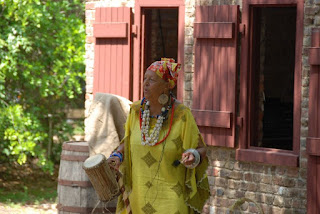A short way outside of Charleston is the Boone Hall Plantation. It claims to be America’s most photographed plantation. It is very impressive. The Avenue of Oaks (as you come into the Plantation), is a 3/4 mile long row of 75 live oak trees. These trees are around 300 years old and are magnificent. In fact, if you’ve seen the movies “North and South” (with Patrick Swayze; it served as Mont Royal) or “The Notebook” with Halle Berry, or “Queen”, Alex Haley’s sequel to “Roots”, then you’ve seen Boone Hall.
Looking down the Avenue of Oaks from the “Big House” (pictured above).
The gardens that surround the Plantation have one of the oldest collections of antique roses that date back more than 100 years. It was very fragrant and in bloom when we visited!
The Boones of Boone Hall were not notable in and of themselves, but two of their sons have a place in history. John Rutledge grew up to become Governor of South Carolina and an author of parts of the US Constitution. John’s brother, Edward, was the youngest signatory of the Declaration of Independence. Another item of note, Boone Hall Plantation produced the bricks that were used in the building of Ft. Sumter and other Charleston landmarks! The Plantation is on the National Register of Historic Places. The property has the original brick smokehouse used by the Plantation since the 1700’s and nine original slave cabins (built of brick, not wood) that were home to the skilled slaves that supported the Plantation (below). These cabins are located near the main home, and housed the blacksmith, seamstress, cooks, and other skilled laborers that were required to support the house in its day to day operation. The field hands’ cabins were made of wood and were located closer to the fields where they worked. None of those cabins survive (but we did see some that were similar back during our visits to the plantations around New Orleans)
What is very interesting is, in each of the cabins, they tell a successive story of the history of slavery and Civil Rights in America. Artifacts and other multi-media present a very informative part of this chapter in our history.
There is a presentation on the Gullah Culture. The Gullah is the culture that is unique to the low country slaves in the South Carolina area. We didn’t get to hear the whole presentation, but what we did see was very interesting and informative.
The walls that surround the main house are also made of bricks made by the slaves. This intricate and elaborate curving of the wall is very impressive.
The folks here have done a magnificent job of showing life on a plantation from both sides, master and slave, and have done it in a forthright and unvarnished manner. I would recommend this place to anyone. It is a very informative and interesting place to visit.








No comments:
Post a Comment